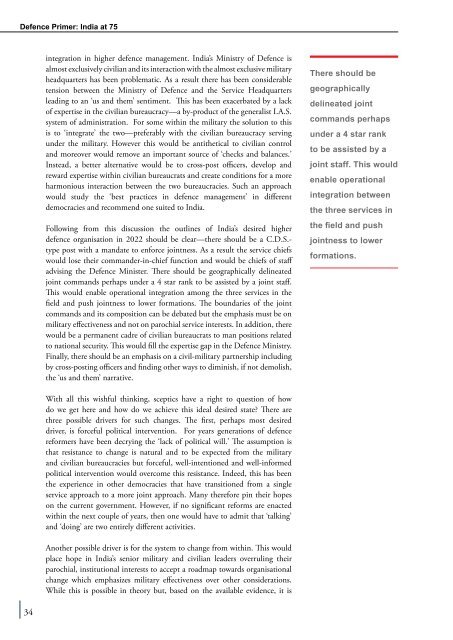Defence Primer
Military_Layout
Military_Layout
You also want an ePaper? Increase the reach of your titles
YUMPU automatically turns print PDFs into web optimized ePapers that Google loves.
<strong>Defence</strong> <strong>Primer</strong>: India at 75<br />
integration in higher defence management. India’s Ministry of <strong>Defence</strong> is<br />
almost exclusively civilian and its interaction with the almost exclusive military<br />
headquarters has been problematic. As a result there has been considerable<br />
tension between the Ministry of <strong>Defence</strong> and the Service Headquarters<br />
leading to an ‘us and them’ sentiment. This has been exacerbated by a lack<br />
of expertise in the civilian bureaucracy—a by-product of the generalist I.A.S.<br />
system of administration. For some within the military the solution to this<br />
is to ‘integrate’ the two—preferably with the civilian bureaucracy serving<br />
under the military. However this would be antithetical to civilian control<br />
and moreover would remove an important source of ‘checks and balances.’<br />
Instead, a better alternative would be to cross-post officers, develop and<br />
reward expertise within civilian bureaucrats and create conditions for a more<br />
harmonious interaction between the two bureaucracies. Such an approach<br />
would study the ‘best practices in defence management’ in different<br />
democracies and recommend one suited to India.<br />
Following from this discussion the outlines of India’s desired higher<br />
defence organisation in 2022 should be clear—there should be a C.D.S.-<br />
type post with a mandate to enforce jointness. As a result the service chiefs<br />
would lose their commander-in-chief function and would be chiefs of staff<br />
advising the <strong>Defence</strong> Minister. There should be geographically delineated<br />
joint commands perhaps under a 4 star rank to be assisted by a joint staff.<br />
This would enable operational integration among the three services in the<br />
field and push jointness to lower formations. The boundaries of the joint<br />
commands and its composition can be debated but the emphasis must be on<br />
military effectiveness and not on parochial service interests. In addition, there<br />
would be a permanent cadre of civilian bureaucrats to man positions related<br />
to national security. This would fill the expertise gap in the <strong>Defence</strong> Ministry.<br />
Finally, there should be an emphasis on a civil-military partnership including<br />
by cross-posting officers and finding other ways to diminish, if not demolish,<br />
the ‘us and them’ narrative.<br />
There should be<br />
geographically<br />
delineated joint<br />
commands perhaps<br />
under a 4 star rank<br />
to be assisted by a<br />
joint staff. This would<br />
enable operational<br />
integration between<br />
the three services in<br />
the field and push<br />
jointness to lower<br />
formations.<br />
With all this wishful thinking, sceptics have a right to question of how<br />
do we get here and how do we achieve this ideal desired state? There are<br />
three possible drivers for such changes. The first, perhaps most desired<br />
driver, is forceful political intervention. For years generations of defence<br />
reformers have been decrying the ‘lack of political will.’ The assumption is<br />
that resistance to change is natural and to be expected from the military<br />
and civilian bureaucracies but forceful, well-intentioned and well-informed<br />
political intervention would overcome this resistance. Indeed, this has been<br />
the experience in other democracies that have transitioned from a single<br />
service approach to a more joint approach. Many therefore pin their hopes<br />
on the current government. However, if no significant reforms are enacted<br />
within the next couple of years, then one would have to admit that ‘talking’<br />
and ‘doing’ are two entirely different activities.<br />
Another possible driver is for the system to change from within. This would<br />
place hope in India’s senior military and civilian leaders overruling their<br />
parochial, institutional interests to accept a roadmap towards organisational<br />
change which emphasizes military effectiveness over other considerations.<br />
While this is possible in theory but, based on the available evidence, it is<br />
34


